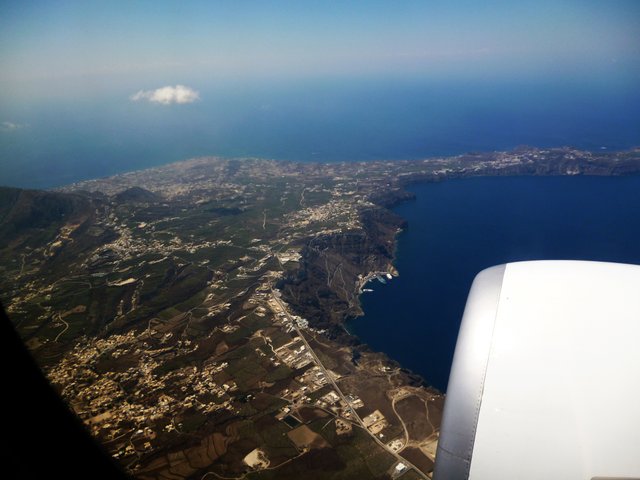one day in Greece #1
hello to all I will share with you but July 2011 holidays.
here is our arrival in Santorini by plane.

Santorini, in Greek Σαντορίνη/ Santoríni, also called Thera or Thíra, / Thíra, is an island of Greece located in the Aegean Sea. It is the largest and most populated island of a small volcanic archipelago with four other islands, sometimes given its name (see archipelago of Santorini).
This island and those of Thirassía and Aspronissi are the remains of an ancient island partially destroyed around 1600 BC during the Minoan eruption2.
Santorini is one of the main tourist destinations in Greece, with its white villages with blue domes perched on top of the cliffs, its panoramas over the other islands and its archaeological sites, notably those of the ancient city of Thera and Akrotiri, where Minoan ruins were found.
The current island of Santorini is, along with the islands of Thirassía and Aspronissi, one of the fragments of an ancient island partially destroyed around 1600 BC by the Minoan eruption.
According to Herodotus, the island was inhabited by the Phoenicians when the hero Theras founded the Dorian colony of Thera in archaic times. The island subsequently belonged successively to the Delos League, Ptolemaic Egypt, the Byzantine Roman Empire, the Duchy of Naxos and the Venetians from 1204 to 1579, the Turks until 1821 and finally to Greece under the London Treaty of 1840.
The last eruption of the archipelago took place in Néa Kaméni from 10 January to 01 February 1950. Rather weak, it produced a small lava dome. This event followed a series of low- to moderate-type ground-level explosions that opened two vents at the location of cracks developed during previous eruptions. The total surface area of the new lava was 7,312 square metres7'8.
In 1956, the island was hit by an earthquake that killed about 50 people and destroyed more than 2,000 homes.
In 1970, Akrotiri's frescoes are brought to light, the best known of which are those known as "child-boxers","fishermen with coryphenes" and "blue monkeys", witnesses of the Minoan civilization dating back to the 2nd millennium BC. Important collections of ceramics have also been excavated from the field. These works of art were spared the Minoan eruption and buried beneath volcanic ashes and pumice.
During the year 2011, the island underwent a seismic activity related to the swelling of the magmatic chamber located at 4 km depth, detected by 20 GPS stations installed since 2006.
Now you knew a little bit more about santorini.
now I'm tired. followed me for the rest of the adventure.
